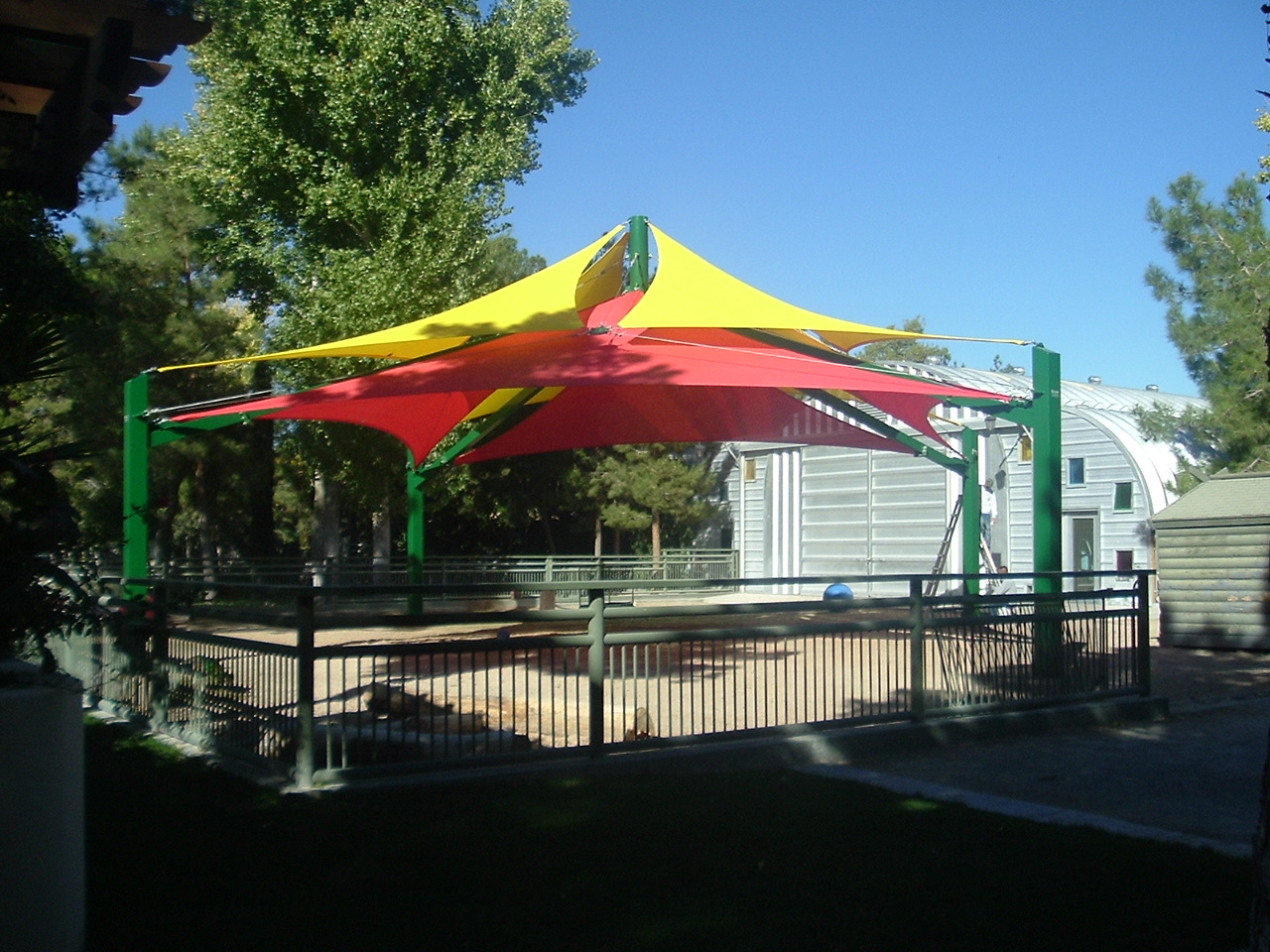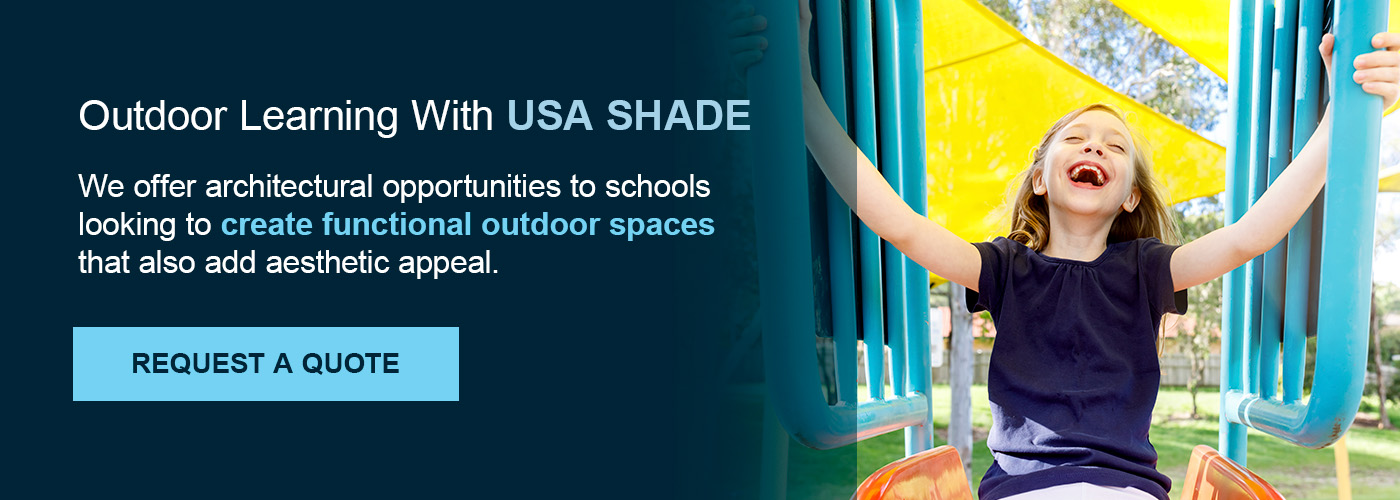

How to Use School Funding Effectively
School funding is the money given to school administrators to maintain and improve their building, campus or learning environment. When school leaders receive funding, they can apply it where it is most necessary to improve their school and enhance their ability to foster a positive learning environment. Some funding types may have specific requirements or conditions on how a school can spend the money and affect students and their education differently.
In this post, we explore how funding affects students, plus creative ways to use funding to improve school structures and the overall learning experience.
Table of Contents:
- How Does Funding Affect Education?
- How to Plan Your School Funding
- Ways to Use School Funding
- Unique Ideas to Use Your School Funding
How Does Funding Affect Education?
How does school funding affect students and education overall? Because there are many different ways to spend school funding, it can be a challenge to come to a consensus on the best methods to achieve the best results for students with the funds available. Research has been conducted to understand the effects of funding in schools across different districts. The same themes emerge:
The Quality of Resources
The way schools use their funding can affect the quality of resources in the following ways:
- Better textbooks, lab equipment and computer technology that help both students and teachers.
- Faster internet access to online educational materials previously not available.
- Additional employee benefits that retain and attract new qualified staff with better compensation.
- Increased health and safety benefits for both students and staff.
- Expanding teacher training to gain extra subject expertise and have them utilize technology to its fullest potential.
- New school facilities to improve academic outcomes, initiatives and school attendance.
- Automating certain tasks with technology to save teachers time.
The Level of Support
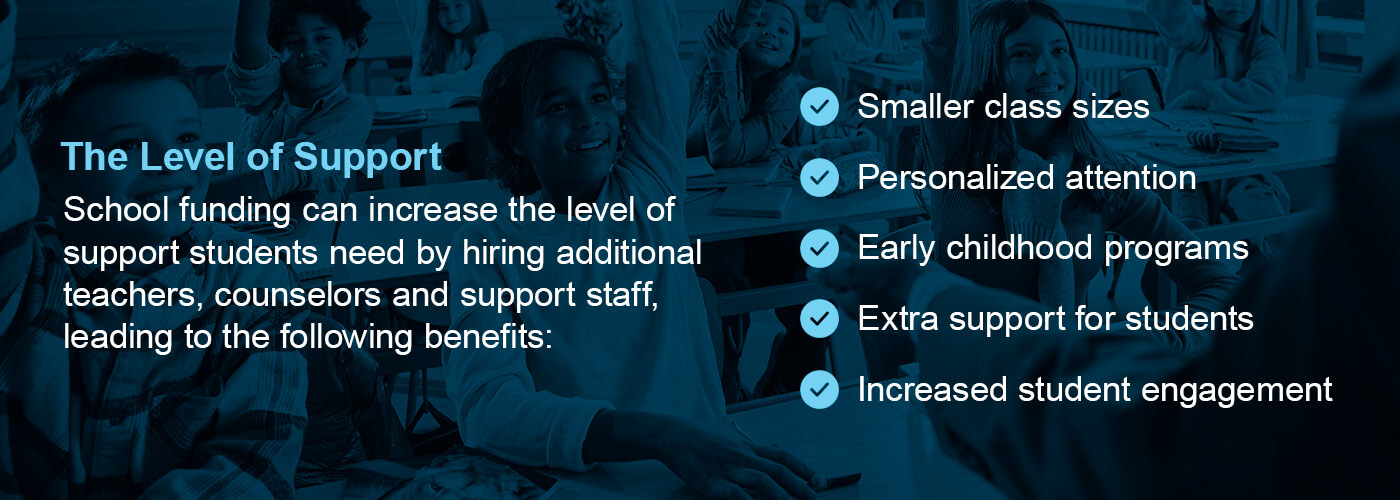

School funding can increase the level of support students need by hiring additional teachers, counselors and support staff, leading to the following benefits:
- Smaller class sizes.
- Personalized attention for students.
- Early childhood programs.
- Extra support for students experiencing physical or learning challenges.
- Increased student engagement and academic achievement.
The Quality of Education
Since funding can increase the quality of resources and level of support, the quality of education also improves:
- Qualified teachers perform better and lead to high-quality instruction in the classroom.
- Experienced teachers can cover their subjects more comprehensively and enrich students’ knowledge.
- Students develop a diverse set of skills and expand on their thinking abilities.
- Kids tend to develop better reading and mathematical skills with better quality education.
- Students receive better test scores and increase their chances of attending college.
Ultimately, it isn’t what they spend but rather how schools decide to spend their funds that can make a difference in the quality of resources and education. When schools receive adequate funding, they can spend it productively, whether on resources, equipment or infrastructure.
How to Plan Your School Funding
When planning how to use your school’s funding, it can be unclear where to begin. While preparing to use your school funding is a detailed process, there are six essential steps to consider. These six steps can help provide structure to school administrators in determining how to use the money effectively.
1. Learn the Basics
The first and possibly most crucial step to creating an effective school funding plan is understanding the fundamentals. School funding can come from various sources, which means the money may come with specific requirements on how schools can spend it.
- General: General aid uses specific calculations to determine the amount each school district should receive from the state.
- Flat rate: The flat-rate method is also known as local effort equalization. This approach uses a financing system that determines a school’s quantifiable unit of need using details, such as the average daily attendance of students or the total number of students enrolled.
- Foundation: The foundation financing system uses a set per-pupil amount to spend on factors that directly affect and improve students’ ability to learn.
- Full state: Some states fully fund schools without direct correlation to local taxes depending on the school’s location.


2. Plan Your Budget
As with any process, planning is critical when determining how to allocate your school’s funding. Choosing a budget and how much money you will earmark for each aspect of your school can ensure you cover all the basics and maximize the use of your funds. School funding planning can help you determine how your funding budget can adequately achieve your goals. When creating your budget and deciding how to use school funding, it is essential to remember the typical school expenditures.
- Budget balancing: Balancing your budget is a valuable step to ensure your current funding and revenue stream meets your school’s projected spending. Your spending should not exceed your budget or go over the available funding for your school.
- Legal requirements: Depending on the type of school funding you have, there may be specifications or requirements governing how you can spend it. You need to ensure your budget is compliant with any potential conditions or legal obligations.
- Evaluation of costs: Your budget will act as a foundational evaluation of your school’s overall costs. Your school’s budget can provide a basis to analyze and assess your school’s services and expenses.
3. Prioritize Your Needs
When considering your funding, it is crucial to prioritize your needs and determine where your budget may be most helpful. Setting achievable spending priorities can help ensure that you satisfy and meet goals and maximize your school’s funding.
- Goal-setting: The first step of effectively applying school funds is to set realistic, attainable goals. Mapping out these objectives and how extra money can help you realize them is essential to creating a successful funding plan. You may want to consider how these goals will act as an extension of your school’s purpose and overall values or how your school will meet legal stipulations and conditions about how you spend these funds.
- Brainstorming: After determining your goals, you can brainstorm what steps your school needs to achieve them. For example, make a list of any obstacles that might prevent you from succeeding. Whether it is proper staff allocation or a need for materials, you can benefit from brainstorming and determining the ideal solutions to attain these goals.
- Prioritizing: You will want to figure out which projects and goals need attention first. Applying funding to the most vital areas of improvement can be an effective way to implement school funding and create a better learning environment for students.
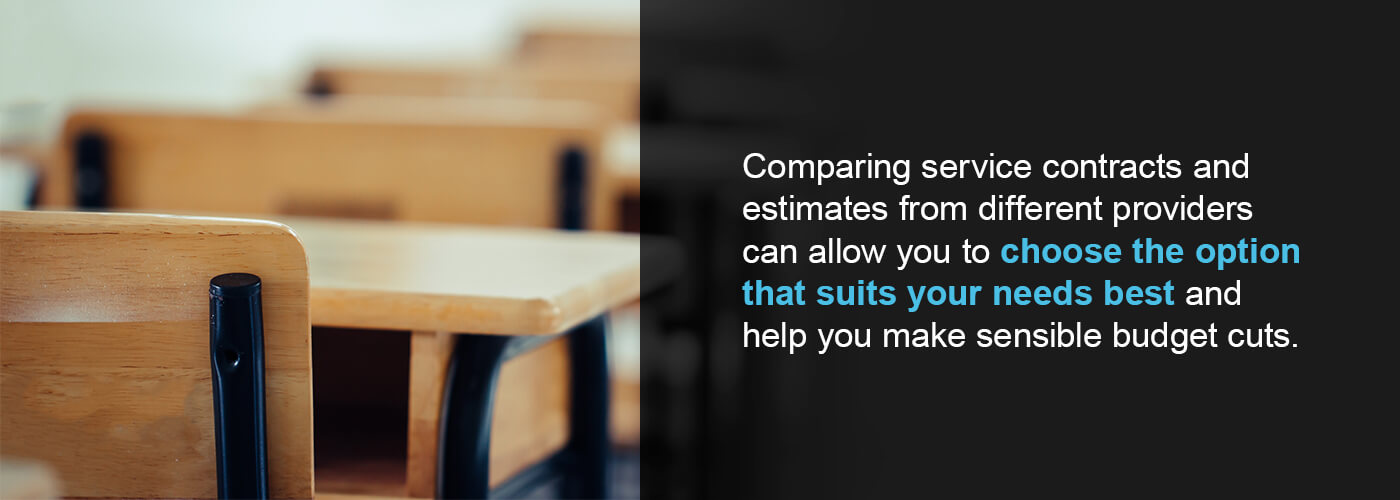

4. Compare Costs
When comparing costs, you will need to look more closely at your school’s current resources and expenses. Determining the existing state of resources and the associated costs can help you understand what goals you can attain and the steps to do so. Additionally, comparing service contracts and estimates from different providers can allow you to choose the option that suits your needs best and help you make sensible budget cuts.
- Analyze actual costs: In creating a budget, you will be using cost estimates to plan how you will allocate your funding. When making a purchase, you will have to compare the product’s actual price to the estimated cost. Cost analysis can ensure that you are staying on track and not going over budget. Depending on a purchase’s price tag, you may need additional funding to complete the project. On the other hand, you may spend less than you estimated, providing you with an opportunity to use this extra funding toward another project to improve your school.
- Evaluate resources: Another essential step to consider during this phase is to evaluate your existing resources. A best practice is to break these resources into relevant categories, including facilities, supplies and personnel.
5. Educate Staff
While some team members may think senior administrators are the only people who need to consider school funding, teachers and other staffers play an essential role, too. It is vital to educate teachers and staff on your school funding and how you use it. Additionally, faculty and staffers will benefit from understanding how each team member has financial accountability.
- Educate teachers: Many teachers may request funds for a specific field trip or crucial materials they may need to help their students learn. Teaching financial responsibility and accountability to teachers and staff can ensure they understand how their actions can affect the school’s funding. It can also provide them with tools to budget appropriately when using the funding to benefit their classrooms.
- Answer questions: Holding a small meeting where teachers and staff can learn about the school’s funding and ask any questions they may have can be beneficial. A school funding meeting can help teachers and staff learn more about your budget and plan, feel more included and foster open and positive communication.


6. Implement Your Plan
After strategizing, budgeting and deciding where to use your funding to improve your school, it is time to make your plans a reality. You can implement your school funding by taking small, actionable steps to help you achieve your goals and create a sustainable budget.
- Plan of action: Your action plan is the financial strategy you create to use your school funding effectively. A plan of action should be an extension of your school’s overall mission that offers guidance on decision-making and features tools for monitoring performance.
- Sustainability: Ensuring sustainability is essential to creating a successful budget and plan. Tools that help you monitor your spending can help you remain within your budget and make any necessary changes.
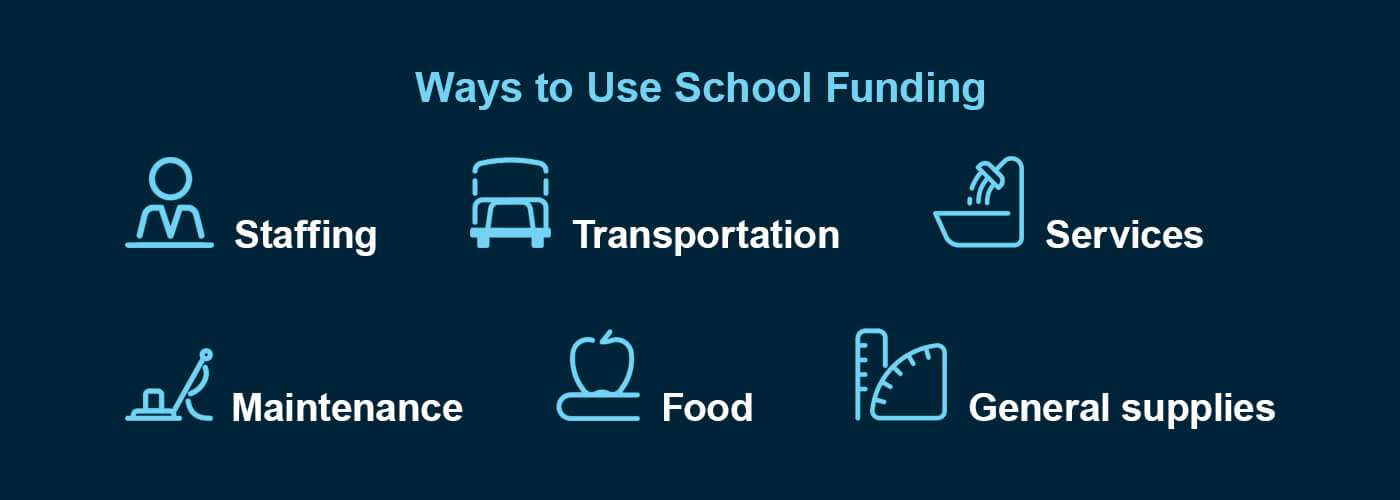

Ways to Use School Funding
What should schools spend money on? While expenses vary widely from one school to the next, schools commonly use funding across six primary areas:
- Staffing
- Transportation
- Services
- Maintenance
- Food
- General supplies
Understanding each of these main areas can help you determine where to allocate your school’s funding to maximize your return on investment. School funding can help schools create a more effective and comfortable learning environment for students while ensuring their safety and promoting personal growth.
Maintenance Upgrades
Maintenance upgrades are an effective way to improve your school’s sustainability and reduce unnecessary expenses in the future. Upgrading from traditional paper filing and billing systems to online software can improve overall productivity and cut back on ink and paper costs. Overall, technology modernizes learning environments and can help save money.
Additionally, energy and electric usage are crucial considerations when making positive changes to create a more sustainable school. For example, schools can switch to energy-efficient options to conserve energy and cut down on costs. Simple behavioral changes, such as shutting down computers and turning off lights each night, can also help schools save on energy costs and use their funding more sustainably.
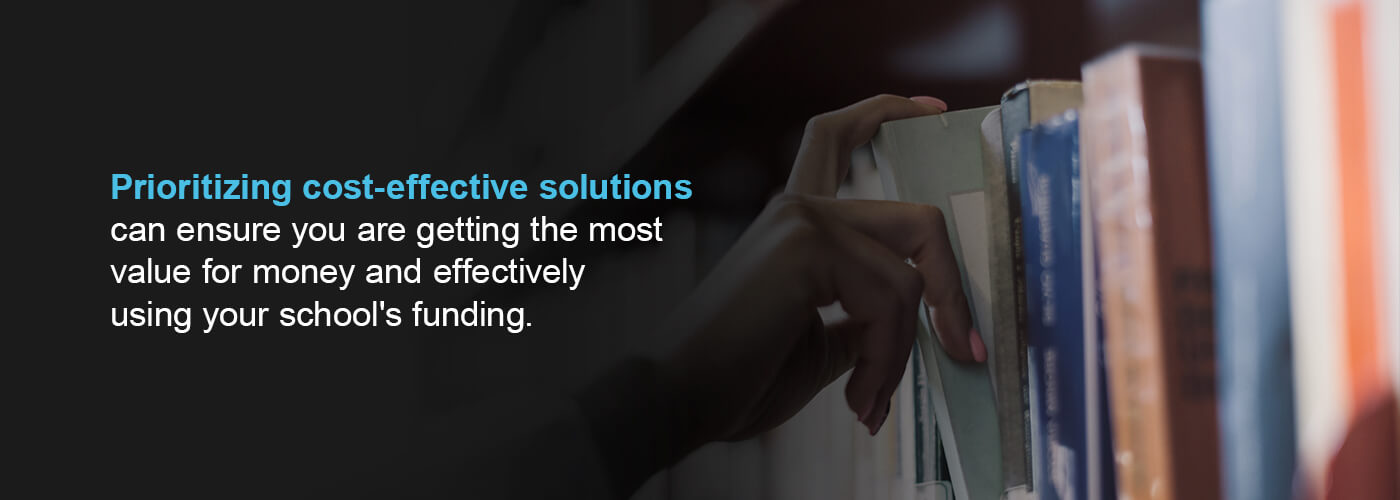

Cost-Effective Choices
Cost-effective or even no-cost options are a helpful way to minimize spending and maximize your school funding and budget. Prioritizing cost-effective solutions can ensure you are getting the most value for money and effectively using your school’s funding.
While it is essential to get high-quality equipment to improve your school, you’ll want to reduce costs where possible to maximize your school’s overall funding. No-cost options are less abundant, but a helpful way to extend funding. For example, some learning software may be free to implement at schools, providing an innovative learning platform that doesn’t chip away at your budget.
Contract Renewals
Contract renewals are a typical use for school funding and are also an excellent opportunity to reduce costs. Typical contracts with schools include insurance, electricity or cleaning services. When a service agreement is up for renewal, school administrators can compare quotes from other providers to select a plan that may be more cost-effective while supplying the necessary services.
Shopping around for different providers may take additional time, but it is a constructive way to ensure you are getting the most of your school’s funding. Cutting costs on contract renewals can free up additional money from your school’s funding to allocate it where you may need it more.
Business Automation
Many schools can benefit from automating specific functions such as payroll and billing. Typically, paperwork for payroll and billing can be time-consuming tasks that require your staff’s attention. By switching to a software or business tool that automates these business processes, you can save money while your employees have more time to work on other responsibilities.
Spending money on business automation can benefit your school by saving money in the long run, as it can increase your staff’s and administration’s overall productivity. This additional time is a valuable asset that employees can use to focus on other areas of improvement for your school. According to WorkMarket’s 2020 (In)Sight report, just over half of employees believe they could save 240 hours a year using automation.
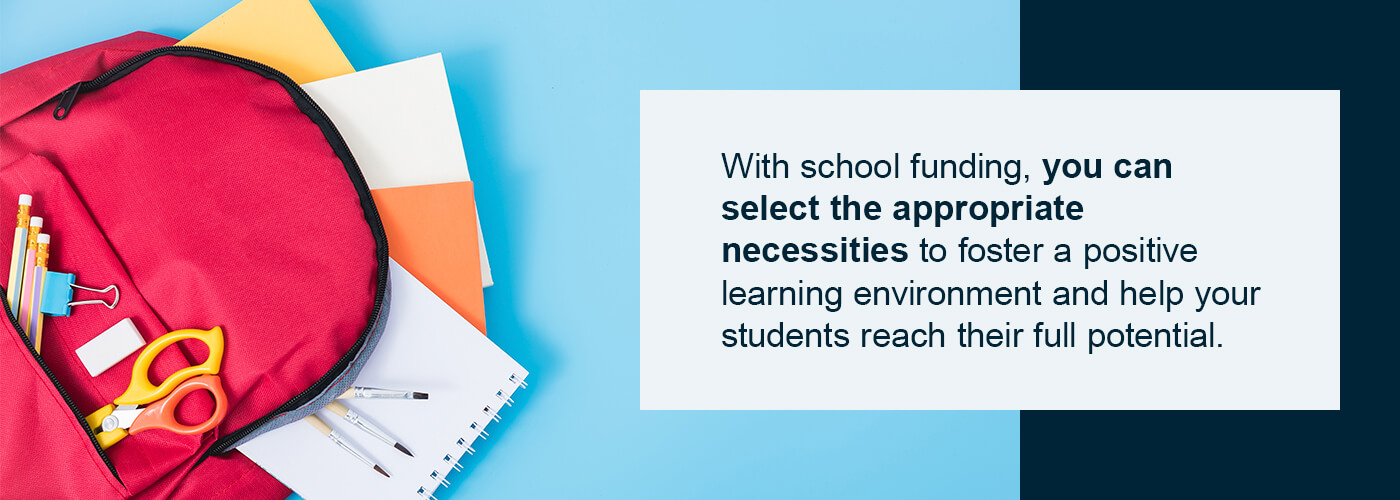

School Materials
Another typical use for school funding is for purchasing new materials and supplies for the school. School funding can help buy new textbooks, notebooks, pencils and other standard school supplies to ensure students have the necessary materials to learn effectively and remain engaged in the classroom.
While expenses vary significantly from school to school, supplies and materials are a universal need for schools and students alike. With school funding, you can select the appropriate necessities to foster a positive learning environment and help your students reach their full potential.
Raise Funds
Many schools can even use the funding they receive to generate new income. Schools can fundraise and create a revenue stream by renting out spaces for events. For example, you might rent gymnasiums or large areas to organizations looking for a place to administer standardized testing or host another event.
Schools can analyze their available spaces, including gymnasiums, auditoriums and even parking lots, to determine if there is a possibility of creating additional revenue streams. Creative fundraising is an excellent way to supplement school funding and help pay for supplies and other necessities.
Construction
Construction costs can include renovating outdated areas of your school or even creating new learning spaces. Many schools may reinvent older classrooms to be more ergonomic and foster a positive learning environment for students. Other standard upgrades for schools include bathrooms, cafeterias, gymnasiums and auditoriums.
Some schools may not need to update existing spaces, but choose to add to their overall design. For example, a school with a growing student body can add classrooms or learning areas. Many schools also build shade structures, providing an engaging outdoor learning space for students to enjoy.
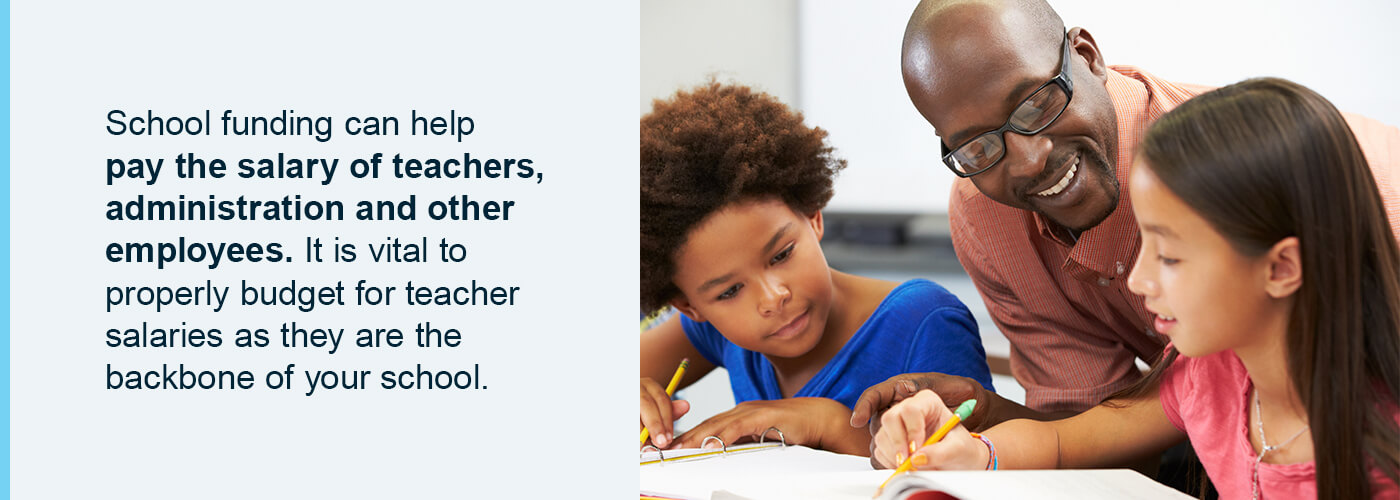

Teachers
Teachers are one of the most essential and valuable facets of any school and learning environment. School funding can help pay the salaries of teachers, administration and other employees. It is vital to properly budget for teacher salaries as they are the backbone of your school. You can show value and appreciation by paying teachers a fair wage for their hard work. An effective teacher can help raise a student’s grades and increase their likelihood of graduating from high school.
While administrators may spend a school’s budget in various ways, you’ll want to prioritize paying your staff competitively, which can show your appreciation and help you attract the best teachers to your school. By attracting the best teachers, you can help your students learn more and create a positive learning environment that engages and encourages the growth of students and staff alike.
Transportation
Transportation is a valuable investment that helps students get to and from school. Administrators can use school funding to purchase transportation or repair existing school buses or other vehicles. Student transportation is a vital aspect of any school that funding can improve and ensure that students can safely and comfortably get to school each day.
School administrators may also need to purchase or repair vehicles employees use. For instance, maintenance workers may require a pickup truck to care for the building or property. Investing in transportation can benefit a school immensely and ensure the safety of its students.
Using School Funding for Outdoor Learning Areas
There are many ways to use school funding to increase productivity and help students learn. While traditional funding ideas are beneficial and necessary, schools may also consider using school funding more creatively. Outdoor learning areas effectively use school funding to engage students and extend indoor classrooms to the beautiful outdoors.
Before moving students outdoors for a session, it’s vital to provide enough cover and shade. Here are three creative ways to provide shade outside the school:
Trees
Trees can provide natural shade and shelter, especially if the school needs more greenery. With some planning and preparation, schools can plant fast-growing trees and have some protection from sunlight any time of year. Students can also get involved with tree-planting projects to learn about its importance and benefits in sustainability and ecosystems.
Umbrellas
If you have limited space that needs shading, a movable, non-permanent solution may be ideal. Umbrellas come in different shapes, sizes and colors and can be hoisted alongside tables and benches. Ideally, even if only as temporary shading, umbrellas should be strong and stable enough to withstand most weather conditions, especially windy days.
Shade Structures
Shade structures are a unique way to create an outdoor learning environment for students. Combining functionality and comfort, premium shade structures and products can improve the usability of outdoor spaces by creating outdoor classrooms. Extending classrooms and traditional lessons to the outside world can create a safe, effective and engaging learning environment that intrigues students and increases productivity. In addition to being an effective classroom, outdoor spaces are also useful for assemblies, dining areas or other student activities.
Benefits of Covered Outdoor Learning Areas
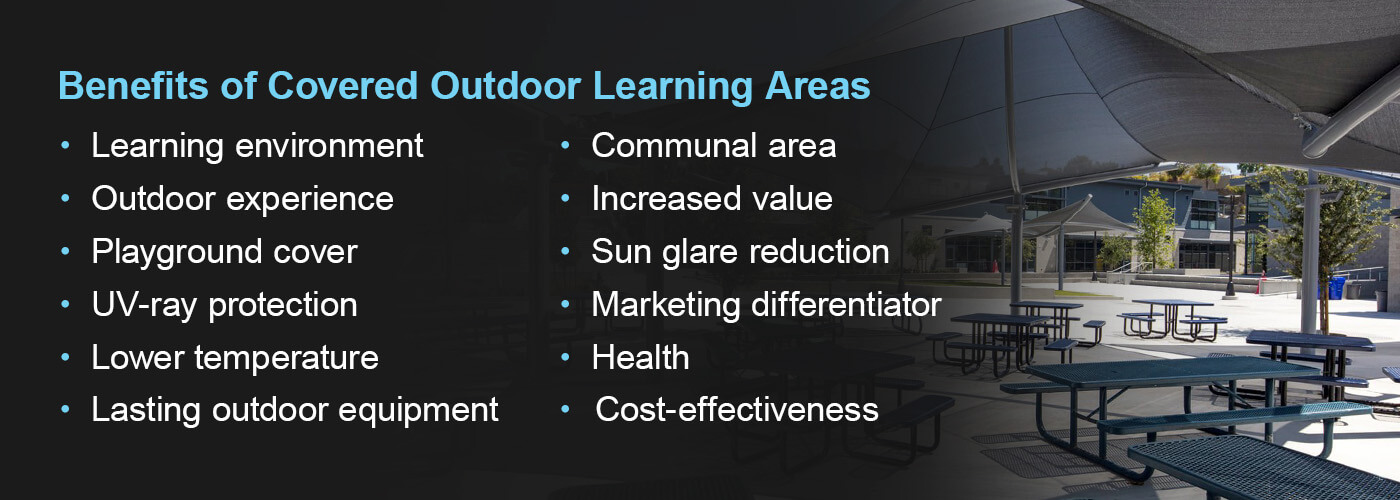

Outdoor learning areas are an excellent addition that can provide a structured, yet engaging learning experience for students. There are many outdoor learning benefits for students and teachers to help children learn and succeed in their academic careers. Shade structures can help create unique outdoor classrooms that can change the way students learn and encourage them to develop their skills further.
- Learning environment: Shade structures can create an outdoor learning space for students to use. Research has shown a class spent in nature can help kids be more attentive and improve focus when they return indoors. Additionally, shade structures allow you to expand classrooms if a teacher prefers to teach a particular lesson or class outdoors. A shade structure is an effective use of school funding that can create a comfortable outdoor learning environment.
- Outdoor experience: Outdoor learning areas allow you to experience the sunshine and the beauty of the outdoors. Spending time in the sunlight can feel rejuvenating and offer a welcome breath of fresh air compared to indoor classrooms. Additionally, shade structures offer easily accessible shade if the sun is too warm or intense.
- Playground cover: In some cases, schools may also use shade structures to cover play areas to offer additional sun protection for students enjoying outdoor activities or recess. A shade structure can add to the overall aesthetic of the playground while providing cool shade during warm, sunny days.
- UV-ray protection: While the sunshine is beautiful, it gives off damaging UV rays. Sunshine can provide various benefits in moderation, but continued or excessive exposure to UV rays can be dangerous. Shade structures can provide a safe and comfortable area to enjoy the beauty of the outdoors while also offering protection against potentially harmful UV rays.
- Lower temperature: When the weather is too warm, shade structures can provide a cool place to rest and relax. Shade structures offer a refreshing temperature reduction in shaded areas that can make outdoor lessons or activities more comfortable, allowing students to fully focus on a lesson.
- Lasting outdoor equipment: Since shading offers lower temperatures and UV protection outdoors, it also protects and increases the life span of outdoor equipment, such as furnishing and playgrounds, from the elements.
- Communal area: Outdoor learning areas often act as communal areas where students and teachers may spend time together during class breaks. Shade structures represent a focal point for schools and can be an attractive amenity for potential students while also serving as a shared space. Outdoor learning areas can also serve other uses, such as performances, assemblies or meetings.
- Increased value: Shade structures can also increase the overall value of your school and campus, as they are an aesthetically pleasing addition that provides a range of benefits.
- Architectural aesthetics: Shade structures can be one of the best ways to use school funding that improves the learning experience while enhancing a school’s architectural aesthetics. Many school leaders also enjoy that specialty shade structures and designs can set their campuses apart from other schools. Shade structures can create an attractive outdoor environment and represent an additional selling point that makes your campus unique.
- Sun glare reduction: Classrooms are more technologically advanced than they used to be a few years ago. Glare caused by sunlight can impair one’s vision and ability to look at computer and device screens. Shades can lower this discomfort.
- Marketing differentiator: The outdoor learning areas could be another differentiator to market to potential parents and new students, demonstrating the school’s understanding and care for everyone’s welfare. Additionally, shades can help schools stand out with distinctive brand colors and logos.
- Health: Outdoor learning areas make use of vacant space on school grounds, benefiting from fresh air and breezes. Natural ventilation makes it less likely for viruses to spread among groups, potentially promoting overall health and lowering student absenteeism due to illness.
- Cost-effectiveness: It’s easy to go over budget when building new classrooms. If a full-scale remodel is not possible, shade structures are one of the most cost-effective ways to provide cover and expand outdoor spaces. Unlike trees and natural shade covers that need constant upkeep, shade structures are sturdy, last long and require minimal maintenance, giving your school great value for money over the long run.
5 Types of Shade Structures for Schools
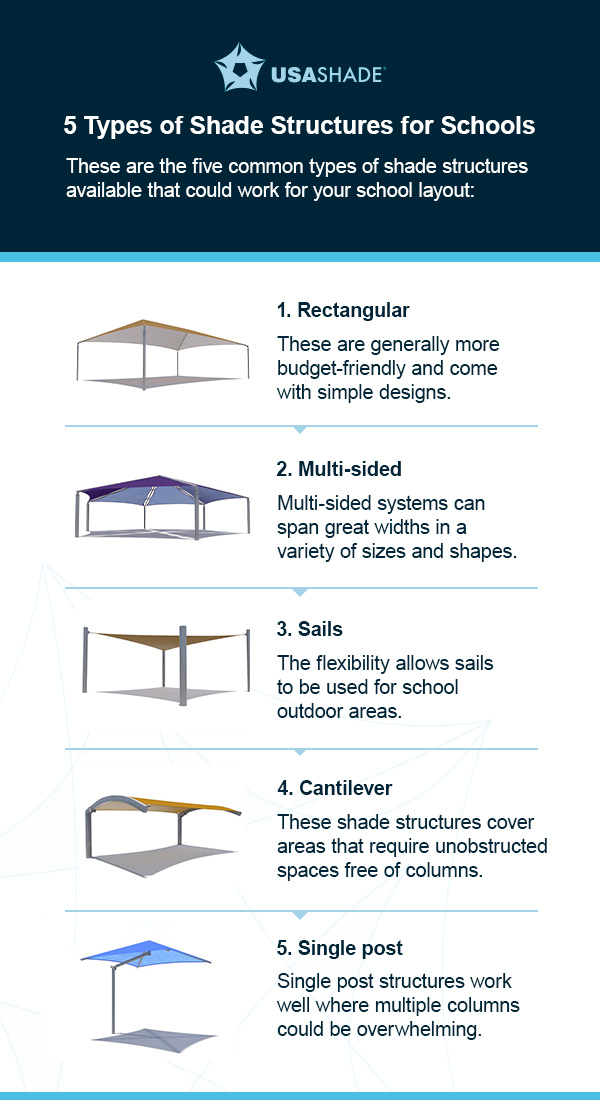

While any area outside the school can benefit from some shade, shade structures need to be placed methodically to truly be beneficial. These are the five common types of shade structures available that could work for your school layout:
- Rectangular: Rectangular or square shade structures can shade large areas, such as play spaces and outdoor seating. These are generally more budget-friendly and come with simple designs that won’t detract from structures already on the school grounds.
- Multi-sided: One of the most modern shade structures, multi-sided systems can span great widths in a variety of sizes and shapes, from triangles to octagons and everything in between.
- Sails: With varying column heights, shade sail fabric can conform to unique shapes to give any space an innovative look. The flexibility allows sails to be used for school outdoor areas, including play and seating areas, sports fields and pools.
- Cantilever: These shade structures cover areas that require unobstructed spaces free of columns. Cantilever shade structures are ideal for spaces where you need a clearer view, set up tables or arrange seating.
- Single post: Single post structures work well where multiple columns could be overwhelming or struggle to fit logically. They still provide plenty of protection while allowing more space for moving around underneath.
Outdoor Learning With USA SHADE
At USA SHADE, we offer architectural opportunities to schools looking to create functional outdoor spaces that also add aesthetic appeal. We are a full-service manufacturer of shade structures located in the U.S. Our shade structures can protect outdoor equipment, play areas and more to offer a unique outdoor learning area. We dedicate ourselves to providing clients with uncompromising quality and building lasting partnerships with unlimited possibilities.
A leading pioneer of shade structures, we design, engineer, manufacture and install high-quality shade structures for schools. Our team of shade structure experts is available to answer any question you may have and assist you every step of the way, from design to installation.
Browse our selection of shade structures and request a quote online today.


